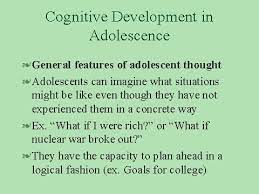Cognitive Development in Adolescence. 2022 Best

For this assignment we will explore Cognitive Development in Adolescence. For this module, the task is easy. I am giving us a break from watching lecture this week! Here is your task: Enter the folder to find the chapter and discussion link.
Cognitive Development in Adolescence.
Welcome to Module 11: Cognitive Development in Adolescence. For this module, the task is easy. I am giving us a break from watching lecture this week! Here is your task: Enter the folder to find the chapter and discussion link. Read the chapter and answer TWO (or as many more as you like) of the review questions I pose. Don’t fret, this text chapter is written in simple terms and you have already been exposed to MOST of the concepts! Ask questions in the forum and answer the discussion prompts. YOU WILL NOT BE TESTED ON THIS CHAPTER FOR YOUR FINAL EXAM – your two responses are the only requirement for this module.
Cognitive Development in Adolescence.
Read through the discussion questions FIRST (see below) to see which interests you most, and take notes as you read through the chapter sections! Here are the sections up for grab in the chapter and the discussion questions for each. Your two required responses must come from different sections. From a developmental neuroscience perspective (pg 342-344), the Discussion Question is to Describe the major neurological developments in adolescence, and explain how they might enable changes in cognitive processes. For perception (pgs 345-346), we are now attempting to understand motor performance in conjunction with visual perception (what we see).
Cognitive Development in Adolescence.
We call this perceptual motor development. The Discussion Question for this section is to Describe and critique the Plumert et al (2007) study of perceptual motor development in childhood and adolescence. For Attention & Executive Functioning (347-350), we revisit the Stroop task!! What new results can we add to our earlier findings? We also introduce a new task, called the antisaccade task (30 second video demonstration https://youtu.be/1NQ0hTBkRS8). This task, like the Stroop, can be used to measure attention. https://youtu.be/wnpDRW43sHk
Cognitive Development in Adolescence.
Your Discussion Question is to Compare the Stroop and Antisaccade tasks as measures of attentional control. What are the pros and cons of each? For Working Memory (pgs 350-353) and Long-Term Memory (pgs 353, 355-356), review and describe the cognitive developments in the working and long-term memory systems. For Developments in higher-order cognitive processes (pgs 356-365), you have many choices! 1) Explain how the findings of Osherson and Markman on reasoning with tautologies (a phrase or expression in which the same thing is said twice in different words) and contradictions supports Piagetian descriptions of formal operations.
Cognitive Development in Adolescence.
2) Explain how improvements in adolescent reasoning, a higher-order cognitive process, might be explained in terms of either basic neurological developments or developments in basic cognitive processes. 3) Describe and critique the Kuhn and Pease study of learning and problem solving in children and adolescence. 4) Compare and contrast the experiential and analytical information-processing systems, and describe the role each might play in adolescent decision making. 5) Review the arguments for why adolescents seem to take more risks than do children or adults, and explain how this can be accounted for by both experiential and analytic information processing systems.
Additional Files







